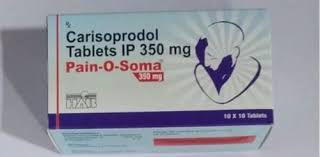
Introduction
Pain management is a critical component of healthcare, particularly for individuals suffering from acute or chronic pain. Carisoprodol (Pain-o-Soma), available in dosages of 500 mg and 350 mg, is often used in conjunction with other medications, including opioids, to enhance pain relief. While opioids are highly effective for managing severe pain, they come with significant risks, including dependence, tolerance, and overdose. This comprehensive guide explores how to safely take opioids for enhanced pain relief, especially when used alongside Pain-o-Soma.
Understanding Opioids and Their Use
What Are Opioids?
Opioids are a class of drugs that include both prescription pain relievers (such as oxycodone, hydrocodone, morphine, and fentanyl) and illegal drugs (such as heroin). They work by binding to opioid receptors in the brain and spinal cord, which reduces the perception of pain.
Indications for Opioid Use
Opioids are typically prescribed for:
Acute pain, such as post-surgical pain or pain from a severe injury.
Chronic pain, particularly when other pain management strategies have been ineffective.
Cancer-related pain and palliative care.
Carisoprodol (Pain-o-Soma) in Pain Management
Mechanism of Action
Carisoprodol acts as a muscle relaxant and central nervous system depressant. It is metabolized into meprobamate, which has anxiolytic and sedative properties, enhancing the drug’s muscle-relaxing effects.
Dosage Considerations
Pain-o-Soma 500 mg: Suitable for patients with more severe pain and muscle spasms.
Pain-o-Soma 350 mg: Often prescribed for patients with milder symptoms or those who are more sensitive to medications.
Safe Use of Opioids
Prescription Guidelines
Assessment: Comprehensive evaluation by a healthcare provider, including pain intensity, underlying conditions, and risk factors for opioid misuse.
Initiation: Start with the lowest effective dose and short-acting opioids. Reserve long-acting or extended-release formulations for severe, chronic pain.
Monitoring: Regular follow-ups to assess efficacy, side effects, and signs of misuse or dependence.
Combining Opioids with Carisoprodol
Enhanced Pain Relief: Carisoprodol’s muscle relaxant properties can complement the analgesic effects of opioids, providing enhanced relief for musculoskeletal pain.
Dosage Adjustments: Careful titration of both medications is necessary to avoid excessive sedation or respiratory depression.
Patient Education: Educate patients on the potential risks of combining these medications and the importance of adhering to prescribed dosages.
Strategies for Safe Opioid Use
Risk Mitigation
Screening for Abuse Potential: Use tools like the Opioid Risk Tool (ORT) to identify patients at higher risk for opioid misuse.
Prescription Monitoring Programs (PMPs): Utilize state-run PMPs to track opioid prescriptions and prevent “doctor shopping.”
Naloxone: Co-prescribe naloxone for patients at higher risk of overdose and educate them and their families on its use.
Non-Pharmacological Interventions
Physical Therapy: Incorporate physical therapy to address underlying musculoskeletal issues and reduce reliance on medications.
Cognitive Behavioral Therapy (CBT): Use CBT to help patients manage pain and develop coping strategies.
Complementary Therapies: Consider acupuncture, chiropractic care, or massage therapy as adjuncts to pharmacological treatments.
Monitoring and Managing Side Effects
Common Side Effects
Sedation: Excessive drowsiness can impair daily functioning and increase the risk of accidents.
Constipation: A common side effect of opioids, which can be managed with dietary changes, hydration, and laxatives.
Nausea and Vomiting: Can often be managed with antiemetic medications.
Serious Adverse Effects
Respiratory Depression: The most dangerous side effect of opioids, especially when combined with CNS depressants like Carisoprodol.
Dependence and Addiction: Risk increases with long-term use. Signs include drug-seeking behavior and withdrawal symptoms when not taking the medication.
Overdose: Symptoms include slow or shallow breathing, extreme drowsiness, and loss of consciousness. Immediate medical attention is required.
Tapering and Discontinuation
Tapering Opioids
Gradual Reduction: Slowly taper the dose to minimize withdrawal symptoms. The rate of tapering should be individualized based on patient response.
Supportive Care: Provide additional support through other pain management techniques and psychological support.
Discontinuation of Carisoprodol
Short-Term Use: Carisoprodol is typically prescribed for short-term use (2-3 weeks) to prevent dependence.
Tapering: Gradually reduce the dose to prevent withdrawal symptoms.
Patient Education and Communication
Educating Patients
Medication Adherence: Stress the importance of taking medications exactly as prescribed and not sharing them with others.
Side Effect Management: Educate patients on how to manage common side effects and when to seek medical help for serious adverse effects.
Safe Storage and Disposal: Teach patients to store medications securely and dispose of them properly to prevent misuse.
Effective Communication
Open Dialogue: Encourage open communication between patients and healthcare providers about pain levels, side effects, and concerns about medications.
Shared Decision-Making: Involve patients in the decision-making process regarding their pain management plan.
Conclusion
Opioids, when used appropriately, can provide significant pain relief, especially for severe or chronic pain. Combining opioids with Carisoprodol (Pain-o-Soma) can enhance pain management, particularly for musculoskeletal pain, by leveraging the complementary effects of both medications. However, the risks associated with opioid use, such as dependence, tolerance, and overdose, necessitate careful management and adherence to safety protocols.
By following best practices for prescription, monitoring, and patient education, healthcare providers can maximize the benefits of opioid therapy while minimizing its risks. Integrating non-pharmacological interventions, such as physical therapy and cognitive-behavioral therapy, can further enhance pain relief and improve patient outcomes.
Ultimately, a comprehensive, patient-centered approach to pain management that includes safe opioid use and adjunctive therapies like Carisoprodol can help patients achieve effective pain relief and improve their quality of life.
